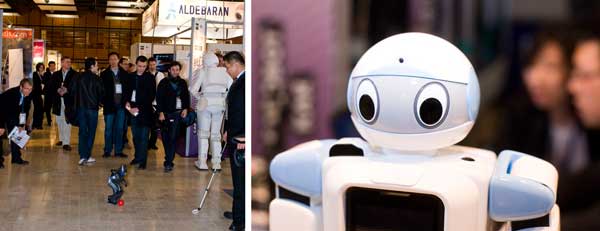In Lyon, France, 14th to 16th March, 2012. Save the date!
By Frank Tobe, Editor/Publisher, The Robot Report (www.TheRobotReport.com)
and Catherine Simon, General Secretary, French Federation of Robotics
and Catherine Simon, General Secretary, French Federation of Robotics
Today’s devices are becoming smarter and connected. They sense their environment, process the data collected and act upon their decisions autonomously or semi-autonomously. The transformation is beyond productivity and enters our daily life in health, safety, transportation, communication, entertainment, chores and more. This trend is a real opportunity for disruptive innovations.
InnoRobo – 14th to 16th of March 2012, in Lyon, France – is gathering the thinkers and doers to their innovation summit to accelerate the emergence of such innovations.
InnoRobo promises to gather top range exhibitors from Asia, North America and Europe and will demonstrate more than 100 different robots, with 30+ displayed for the first time in Europe. The whole emerging robotic ecosystem (creators, technologies, component suppliers, distributors, high end research labs and educational institutions) will be participating in an energetic, open-minded atmosphere, sharing and exchanging with entrepreneurs, investors, reporters and researchers.
Of course there will be some uniquely French things that you won’t experience elsewhere:
In addition to the exhibition hall, there will be conference sessions with five major themes:
Synergies and convergence between Industrial and Service robotics:
Industrial robotics is known for its applications in welding, soldering, handling, painting and assembling, for the automotive, electronics, metal, plastic and chemical industries. But industrial robotics is evolving towards new industries as well as smaller firms. It needs to reinvent itself and produce more flexible, mobile, easily trainable robots to work hand in hand with human workers. The human robot interactions (HRI) in factories and Co-botics are hot topics demonstrating the synergies and convergence that are likely to happen between industrial and service robotics technologies and solutions.
Health and Medical robotics:
The growth of medical robots and surgeon/doctor augmentation devices since the mid-80s has been overwhelming, both as a field of innovation and research but also as a market for new products and services. Medical robotics is considered one of the success-stories of service robotics. It is a prominent segment of growth driven by demographic shifts, rising prosperity in developing countries and advances in medical technology.
Urban robots for citizens:
One vision for the future features a generation of robots designed to play various roles in urban society. Some robots will be guides, others will help the elderly, some will make sure megacities are safe and others will collect our rubbish and do various daily chores. Beyond this we envision intelligent robotics to solve our major societal challenges: mobility with an overwhelming urbanization, and sustainable development for our planet to survive our demanding energy consumption.
Cloud robotics:
Every file, document, database and digital information is now going through the “Cloud”. What does it mean for our future, with machine to machine communication, connectivity for each and every of our daily life object? The imaginary world of Matrix is not so far away: your personal robot can learn with a simple download from the Cloud how to fly a helicopter or cook the perfect dinner.
Human-Robot interactions:
User-centered design is a must for robots to truly become a mass market. Although technologies progress rapidly, and despite the impressive demonstrations of humanoid robots from Japan or elsewhere, we are not there yet. Hence the shape of robots has to be driven both by its functions and by our human expectations. A robotic dog which doesn’t sense my approach remains a gadget, a humanoid robot which cannot engage in a natural conversation will be a disappointment. What is the correct level of interactions with a robot? What is the ideal form factor associated to the functions it performs? What kind of robots are we ready to accept and cooperate with in our daily life? These major questions will be dealt with by researchers, ergonomists, anthropologists and roboticists at InnoRobo.
In short, InnoRobo is all about the emerging business of service robotics, where growth is projected to be a major economic driver of the 21st century’s economy. Robotics will change our life, so it might be worth getting to know when and how. InnoRobo is a way to participate in that process.
For further information: www.innorobo.com









Tell Us What You Think!